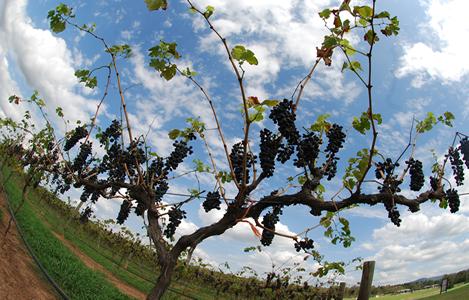|
Summer Wine

Photograph
by Preeti Verma Lal
"Tamburlaine was a ferocious invader, but my wine is ambrosia. Nothing of the evil of the Mongol warrior, but, trust me, the wine is as intense.” Adjusting his mop of snow white hair, Mark Davidson, one of the biggest vintners of Hunter Valley, was deliberating on the etymology of his famous wine called Tamburlaine. He did not rustle that name, but he often has to do a tardy explanation to the wine connoisseurs who are invariably intrigued by the name.
But in Australia’s oldest wine region that stacks in the lush valley hundreds of vineyards, cellar doors and wineries, the stories – and the grapes – get more captivating and intriguing at every vine. People would tell you of the doctor who had a surgery room on the first floor and a wine brewing corner on the ground floor of his log home; the Italian who could adroitly handle the scalpel and the sniff the shiraz in one long breath. And of the vintner who so loved his mother that he created a Rosé blend but dropped the accent and named it after his mother Rose. Of that day in 1797 when a livid lieutenant who was searching escaped convicts chanced upon the Hunter River from which the wine region borrows its name. That opinionated but amateur viticulturist called James Bugsy who first moseyed into the valley with 500 vine cuttings…
Nearly 180 years after Bugsy, I drove into Hunter Valley, without a single vine cutting or even an intention of quaffing the best of the Verdelho, Semillon, Shiraz, Sauvignon…. wines that has lent Hunter Valley its reputation. Wine? That was not my sole reason to be there. You see, there is not even a hint of alcohol in my DNA helix and I was not ready to get hooked to Bacchus, whatever the temptation, whatever the whiff, however succulent the Rieslings.
In the Valley the grapes would have had to wait, it was 8,000 rose plants, hundreds of magnolias, miles of orange trumpet creepers and rows of camellias that first beckoned. By the beige sandstone arches in the Hunter Valley Gardens the pink pansies fluttered in the morning breeze and as the buggy ambled through immaculate pathways, a dream world unfolded in the gardens that have been diligently planned by the Roche family. Spread over 100 acres, the stone ducks, the Indian garden with colossal elephants, the red pagoda, horses of Brokewood Mountains galloping within the topiary make for such an enchanting floral motif that you wonder when the world wriggled into a chintz sheath - the pinks edging out the yellows, the oranges jostling with the fuchsia and the magnolias agonizing the lotus with their pearly white magnificence. But it is the Storyteller’s World that had me nostalgic – in the middle of the garden the Mad Hatter’s Party was chiseled in stone, on a toadstool sat an elf, Jack and Jill tumbled down a grassy hill and Gorgie and Porgie looked pudgy even in their painted stone pinafores and breeches.
“Oh! You are a teetotaler. You must be quite an exception here. Quite like the Brigidine nuns, are you?” Swirling his glass of red wine a fellow traveler was getting sarcastic, but standing in front of the Peppers Convent I chose to forgive all mocking birds. There is a certain serenity around the wooden building that was once the retreat of the Brigidine Order of nuns in Coonamable, about 600 kms away. Interestingly, the convent building was dismantled and transported to the Pepper Tree Winery on large trucks and then were the dowels nailed and the banisters painted to metamorphose the convent into a chic hotel, next to which sits the Roberts restaurant, often touted as the signature restaurant and a must-do in Hunter Valley.
Before I could say kneel and say a prayer, it was the onomatopoeic sound of the horses’ hooves that had me distracted. I looked askance and found Lance and his pair of macho Scottish horses pulling a green old-world carriage – Lance looking dapper in his cowboy hat and bushy sideburns, the horses twitching after a gallop. The Pokolbin horse carriage relives the bygone age when Hunter Valley – and Australia – was shedding its notoriety as a British penal colony, planting the first vines and the roses in the valley where the Hunter river gurgled by.
However, when I walked into Hope Estate a little later, it was not the wine stacked neatly in panted racks that first caught my attention – it was a huge pipe which was spewing endless litres of burgundy liquid into a huge steel container. Never before had I seen so much grape juice, certainly never before seen it frothing out of a large-mouthed hose. At the Hope Estate chairs were being lined up for the Eric Clapton concert but I was kicking my stilettos and rolling up my dungarees to stomp a mound of grapes. Honestly, I hesitated, felt guilty to feet-stomp the dark grapes, a tradition dating back to 200 BC in Rome. The grapes were getting gooey under my feet and in those few minutes I must have stomped enough grapes to fill two goblets.
“So, Hunter Valley did not tempt you to break the no-alcohol vow?” Bilby, a Keralite and probably the only Indian working in a Hunter vineyard, got curious. Jaded with answering the same question with a poker-faced “no alcohol in my DNA” banter this time I took to a beatific wit. “I am like the angels who feast on the wine that escapes from the bungs during evaporation,” I rattled with a smile. In Hunter Valley the winemakers do not whine about the evaporated wine; they call it the Angel’s share. Perhaps I would be reborn as an angel in Hunter Valley? Tonight, I shall drink to this thought!
The Indian Express, 2010
|

